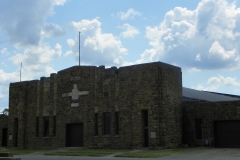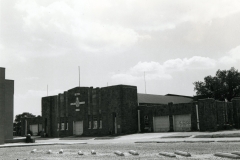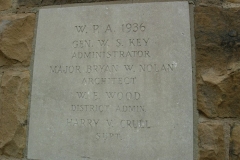| Address: | 500 N. Alabama Ave., Okmulgee, Oklahoma | County: | Okmulgee |
| Started: | December 1935 | Completed: | March 1937 |
| Agencies: | WPA | NRHP: | January 25, 1999 |
Current Usage:
After School Activity center; owned by School District.
Description:
The Okmulgee Armory is a three unit, single-story, rectangular (91′ x 192′) structure constructed of rusticated and coursed native stone of buff color. The roof over the central unit is arched while elsewhere it is flat. All three sections contain parapets. Pilasters at the corners and framing the main entry provide decorative relief–as do vertical indentations in the rock work above the windows and below the parapets, which gives the structure a “fortress” appearance. Some of the elongated, metal encased windows have concrete sills. The armory also contains several garage doors.
As a WPA structure, this armory is exceptional for its quality of workmanship and its scale. Architecturally it is also unique within Okmulgee in terms of style, type, and materials. Construction of this armory provided jobs for destitute workers at a time when the oil and gas industry had problems and farming was at a low point. Okmulgee, a farm trading center, suffered an influx of unemployed people which made public work opportunities particularly important. The project enabled the WPA to infuse wages of some 58,000 manhours of labor into Okmulgee’s economy and thus to ease the impact of the depression along main street.
Between late summer 1935 and mid-1936, Okmulgee city commissioners submitted proposals for several WPA projects, including sidewalks, street grading, storm sewers, school repairs, a stone cascade at Lake Okmulgee, an athletic stadium, a baseball field, a recreation center, a community center, a rose garden, and an armory. In order to obtain WPA approval for its armory proposal, the city deeded a site on the west side of Alabama Street between 1st and 2nd streets (west of downtown) to the State of Oklahoma in August 1935. Statewide armory construction was scheduled to begin on November 1st but was postponed by a federal order that brought several Oklahoma armory projects to a temporary standstill; because Okmulgee’s project had not yet broken ground, it was not among those suspended. The order was rescinded in late November, and construction work began in earnest in December. The sponsor’s share of the cost of the armory was provided in land, materials, and equipment use. The Okmulgee Armory project developed gradually over 1936 as WPA crews erected the huge stone building. By August of that year the walls were completed, steel bowstring trusses were in place, and colored concrete was being poured for the administrative sections. The size of construction crews varied, the largest numbering 80, working in staggered shifts of six hours’ duration. A total of three to four hundred men worked on the armory. The building was fit for occupation during late December 1936, and the National Guard moved in on January 1, 1937. On March 19, 1937, Okmulgee dedicated its new armory with an elaborate program. State WPA director Gen. Key and other state and local dignitaries participated in a program that began with a parade and included a cornerstone-laying by Key and Adjutant General Charles F. Barrett. A celebratory banquet and dance followed, featuring music by the WPA swing band, a sixteen-piece orchestra called the “Sooner Swingsters.” Final interior details were still being completed, however, through June 1937. WPA projects in 1935-1936 propped up the sagging rural economy of Okmulgee County, hard-hit because of extended agricultural depression and severe drought. Major projects in and near the city of Okmulgee included Harmon Athletic Field (football/track facility), a rose garden, and the customary street, sewer, and road work. By May of 1936 more than $500,000 had been expended for 45 projects throughout Okmulgee County. By June of 1937, the WPA had given 2,900 Okmulgee county residents 3,593,218 hours of employment on dozens of projects. The WPA’s share of the $80,000 armory project, the most expensive in the city of Okmulgee to date, was $68,000. In human terms, tens of thousands of person-hours of labor went into the armory’s construction. Most significantly, several hundred men were employed on the project. As with most WPA projects, the armory project was labor-intensive, designed to provide as much work as possible for those on relief rolls. Most of the hours were consumed in hand labor stonecutting and laying, pouring concrete, and installing a wood-block floor in the drill hall (an estimated 100,000 pine blocks were cut, primed, set in asphalt, sanded, oiled, and polished, in sections). A concrete floor would have sufficed, but ample time and labor were available to create a complicated design. It is also significant, and atypical of armory projects, that the men of Company K, 179th Infantry, donated more than 6,000 hours to help build their future home, providing electrical, carpentry, and other work, pouring concrete sidewalks, planting landscaping, and paying for a carved granite insignia over the main entrance; they also donated approximately $3,500 in cash.
Upon completion, the Okmulgee Armory became the home of two 45th Infantry Division units: 3rd Battalion Headquarters unit of the 179th Infantry, and Company K, 179th Infantry.[3]
Sources:
- Oklahoma Landmarks Inventory Nomination
- The Living New Deal
- National Register of Historic Places Registration Form
- Department of Environmental Quality Final Report
Supported Documents:
- WPA Properties Okmulgee County – Okmulgee Armory
- National Register of Historic Places Support Document
- National Register of Historic Places Nomination Form







Leave a Reply